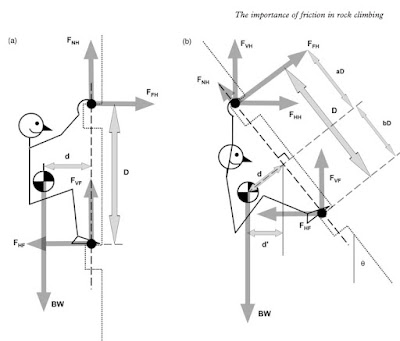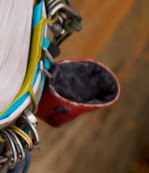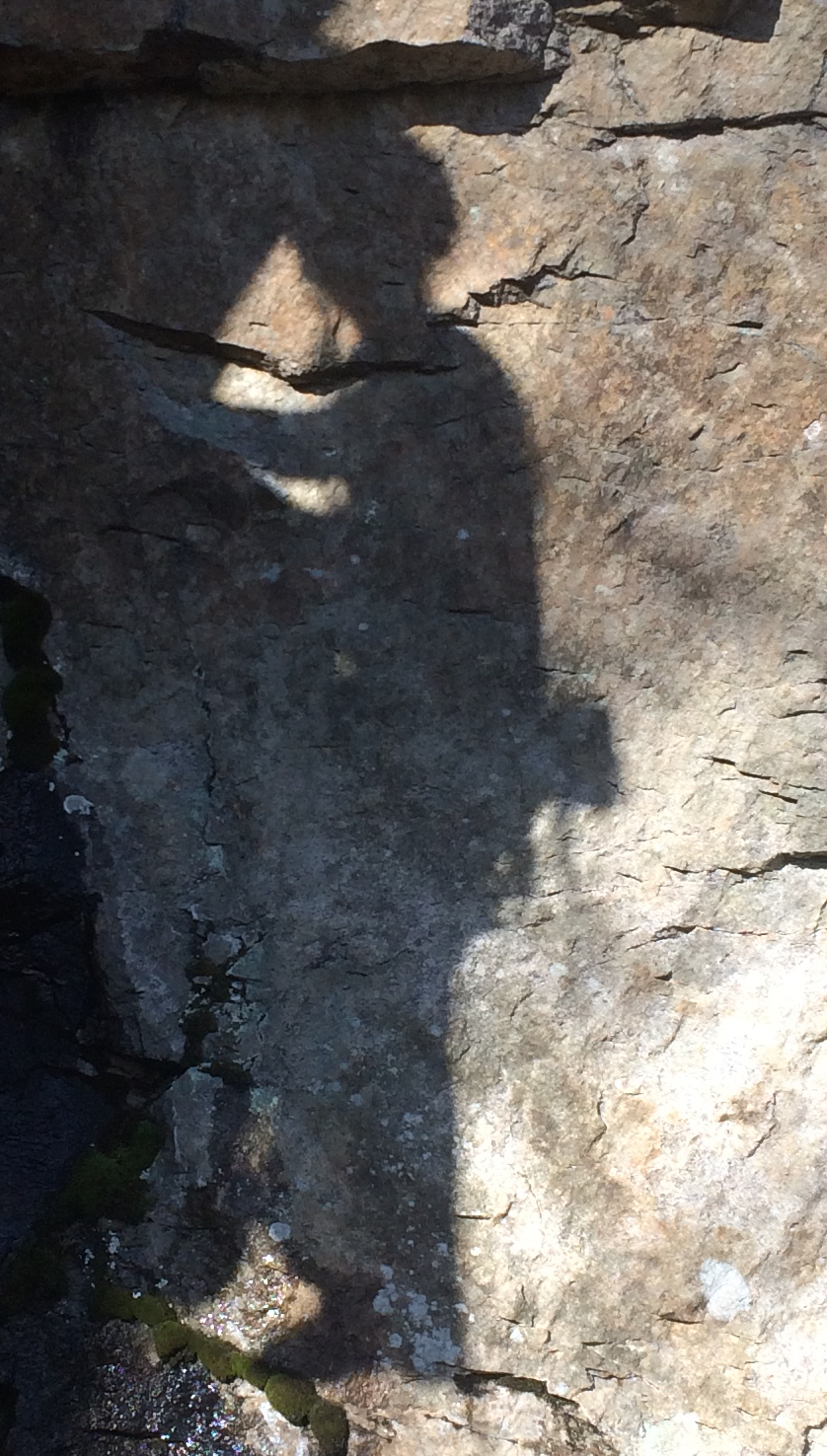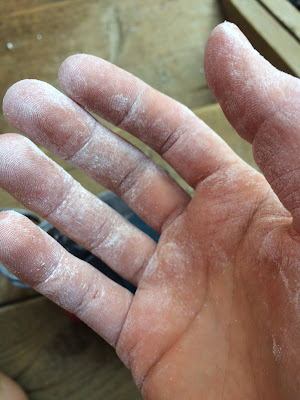Dans les articles précédents, il a été question de risques probables pour la santé de l'utilisation de la magnésie. Pourquoi utilisons nous de la craie et est-ce vraiment nécessaire? Les grimpeurs désirent souvent assécher leur mains pour éviter de glisser sur les prises et à en croire les compagnie qui vendent de la magnésie, celle-ci permettrait d'avoir une meilleure friction. Afin d'analyser si la craie est réellement nécessaire au grimpeur, regardons objectivement si elle aide à mieux maintenir le contact avec la roche ou les prises et en deuxième lieu si elle assèche vraiment les mains.
FRICTION
Pour essayer d'analyser le rôle de la magnésie dans ce contexte, plusieurs auteurs ont donc calculé le coefficient de friction ou de frottement entre la main et les prises dans diverses situations.
Mathématiquement, l'adhérence ou coefficient de friction se définit comme un ratio entre la force tangentielle et la force normale. Ce ratio, µ, est généralement un chiffre entre 0 et 1. Par exemple entre la neige et un ski µ a une valeur de 0,14 (tant mieux, ça nous aide a glisser!) et entre deux morceaux de velcro µ = 6.
En appliquant le concept physique à l'escalade, le coefficient de friction est le ratio des forces verticales sur les forces de friction horizontale entre les surfaces. Le coefficient de friction statique est le point d'adhérence maximale possible, après quoi la main se mettra à glisser sur la surface de la prise ou du rocher.
La première force (verticale) implique la somme de la masse du grimpeur et des forces appliquée par les mains et les pieds, tandis que la force horizontale (tangentielle) tient compte de la distance entre le centre de masse et le mur. Ces forces sont évidemment calculées en tenant compte de l'angle de la prise et du mur.
Selon la loi d'action-réaction: lorsqu'un corps exerce une force sur une surface, le corps subit une force d'égale magnitude, mais de sens opposé. Voilà pourquoi sur le diagramme, les flèches (vecteurs) de force pointent vers le haut.
 |
| Fuss, F.K. (2012) Diagramme des forces sur un mur vertical et sur un mur incliné |
Le sujet du coefficient de friction se complexifie encore d'avantage, car en plus des paramètre discutés ci-haut (position du corps, distance entre le centre de gravité et le mur, distance entre les pieds et les main), plusieurs autres facteurs vont venir le moduler.
L'humidité de la peau, l'humidité et la température ambiante, la rugosité de la prise, l'adhérence au matériel de la prise, l'aire de contact de la peau sur la prise, l'expérience du grimpeur et potentiellement l'utilisation de la magnésie viendront augmenter ou diminuer le coefficient de frottement.
Ceci est du au fait que la peau des propriétés variables et la capacité de se déformer contrairement à un matériau solide. Le coefficient de friction n'est donc pas une constante entre la prise et la peau du grimpeur. Fuss a pu démontrer dans une étude en 2008, qu'un grimpeur élite (dans le top 20 du classement mondial) avait pu générer une valeur de 0,95 de coefficient de friction mesuré par une prise instrumentée de capteurs de force lors d'une voie en compétition. Un autre grimpeur a glissé de cette même prise ayant généré seulement 0,48 de coefficient de friction. Les 23 grimpeurs de cette compétition avaient généré en moyenne un coefficient de friction de 0,63 sur la prise. Ceci veut donc dire qu'avec l'expérience, un grimpeur pourra produire un coefficient de friction plus grand et limiter le glissement.
Une deuxième expérience de l'auteur avait confirmé que la répétition d'une voie améliore aussi les paramètres mécaniques, si bien qu'entre la première ascension et la 8e, le coefficient de friction, tel que mesuré sur une réglette, avait augmenté significativement.
Revenons au cas de la magnésie. Est-ce que celle-ci aide le grimpeur à voir une meilleure adhérence? Malheureusement pour nous, la méthodologie de plusieurs études voulant calculer le coefficient de friction ne reproduit pas la situation réelle de la grimpe. Certains protocoles mesuraient la force pour résister au glissement, alors que les sujets étaient assis et qu'un appareil tirait sur la surface pour la faire glisser. Les forces produites par la main du grimpeur étaient bien en deça de celles d'une situation de grimpe.
L'autre principale critique selon moi est que plusieurs auteurs ont calculé le coefficient de friction statique maximal, mesuré au point imminent de glissement. En escalade, par contre, il n'y aucun avantage et aucune nécessité de s'approcher du point de glissement, car le grimpeur s'approcherait dangereusement d'une chute!
D'un autre point de vue, même si on peut questionner la représentativité des études, voyons quand même ce que ces chercheurs ont trouvé, car le changement de ce coefficient de friction statique maximal pourraient quand même augmenter ou diminuer la "marge de sécurité" qu'à le grimpeur en tenant une prise.
grès (sandstone) : augmentation du coefficient de friction statique maximal chez 2 auteurs sur 3, pas de différence entre la magnésie en poudre vs la magnésie liquide.
calcaire (limestone) : augmentation du coefficient de friction statique maximal chez 1 auteur sur 2.
granite: diminution du coefficient statique maximal
ardoise (slate) diminution du coefficient statique maximal
Donc, sur le calcaire et le grès il y aurait un bénéfice d'utiliser la craie mais ce serait désavantageux sur du granite ou de l'ardoise. Pour un type de roche lisse, ajouter de la craie (une substance granuleuse) aurait l'effet d'un roulement à bille, ce qui diminuerait le coefficient de friction statique maximal. Pour une roche rugueuse, l'utilisation abondante de craie rempli ou bouche les aspérités, diminuant aussi le coefficient de friction. Dans une situation où la roche est mouillé ou lorsque les doigts sont humides ou mouillés, il n'y aurait aucun bénéfice à utiliser de la magnésie solide ou liquide, car le coefficient de friction n'est pas statistiquement différent de la situation "main nues".
ESCALADE INTÉRIEURE
En ordre de coefficient de friction du meilleur au plus petit selon Fuss pour l'escalade sur prise artificielles.1-Craie sur prise propre
2-Main sèche et propre sur prise déjà poffée
3-Craie liquide sur prise propre
4-Main sèche et propre
5-Main mouillée
6-Magnésie sur prise déjà poffée
Premier constat: L'utilisation de magnésie sur une prise neuve améliorerait significativement le coefficient de friction toutes conditions confondues. Cette différence est notable par rapport à l'utilisation de la magnésie liquide, pour une prise propre.
Deuxième constat: sur une prise propre le coefficient de friction entre une main mouillée, sèche ou enduite de magnésie liquide ne serait pas statistiquement différent.
Cependant, à moins que vous soyez un ouvreur ou que vous ayez un mur à la maison il est très rare de grimper sur des prises propre. Ce qui nous amène au
Troisième constat: l'utilisation de magnésie sur une prise déjà polluée réduit significativement le coefficient de friction, par rapport à une main sèche et propre sur cette même prise.
Bref, plus les grimpeurs essaient de bénéficient de la prise neuve avec de la craie, plus elle devient polluée au point qu'une main sèche, sans magnésie devient la solution à adopter. Est-ce qu'il y a donc un désavantage pour les grimpeurs subséquents? Bien que le coefficient de friction entre ces deux conditions n'est pas statistiquement différent, le grimpeur qui veut utiliser une prise déjà enduite de craie devra se laver assécher ses mains pour bénéficier de la même friction, ce qui n'est pas vraiment réaliste en compétition. Le fait de brosser la prise n'élimine pas complètement la magnésie sur sa surface, donc oui il y aurait potentiellement un avantage pour les premiers grimpeurs.
La première étude analysée se concentraient sur le nombre de traction sur des prises d'entrainement. Selon Bacon, l'utilisation de magnésie aiderait à augmenter significativement le nombre de pull-ups effectués à 50% du poids du corps sur des pincettes ou des prise tendues. Les 9 grimpeurs participants ont pu faire en moyenne 3 tractions de plus en open-hand et 5 tractions additionnelles en pinch avec les mains "poffées".
Kilgas tant qu'a lui a calculé plusieurs paramètres lors d'un problème de bloc, précédé et suivi d'une suspension sur poutre. Il pu mesurer qu'en présence de magnésie, les 19 grimpeurs étudiés avaient été capable de se suspendre significativement plus longtemps (14 secondes additionnelles en moyenne). Aucune autre variable mesurée par l'auteur n'a montré de différence statistique. Ni le coefficient de friction, ni l'activation musculaire, ni les forces verticales (mains et pieds), ni l'économie de mouvement, ni le temps de grimpe ne différaient entre la condition avec magnésie ou sans magnésie.
En lumière de leur résultats, les auteurs suggèrent donc un effet psychologique relié à l'utilisation de la magnésie! Pas besoin non plus de mettre de la magnésie si vous faites des tractions sur une barre d'acier, ceci réduirait le coefficient de friction si vos mains sont déjà propres et sèches ou même légèrement humides. Il vaut mieux assécher la barre d'acier si elle devient humide. (Carre)
ASSÈCHEMENT MAINS
Deuxièmement , est-ce que la magnésie assèche vraiment les mains et est-ce que cela aide la performance? Regardons d'abord les caractéristiques de la peau et l'impact de l'humidité.
Notre peau a des propriétés viscoélastique qui lui permettent de se déformer pour augmenter la surface de contact, bénéfique au coefficient de friction. Bourne et ses collègues dans un article de 2011 ont pu démontrer que le fait de pouvoir tenir sur des micro prises (de 2,8mm et 4,3mm) n'était pas relié à la force des doigts absolue, ni le ratio de la force sur la masse corporelle, mais bien à la dimension de la pulpe sous le doigt. Un plus grand "volume" de peau permettrait une déformation plus importante du bout du doigt, augmentant la surface de contact avec la prise. La production de force sur ses prises serait ainsi améliorée. Les auteurs concluent qu'une peau souple serait la clé pour tenir sur des minis réglettes.
D'autres auteurs (Li, Kilgas, Amca) abondent en ce sens: l'ajout d'eau sur la peau améliorerait sa flexibilité et sa capacité à se déformer, ce qui augmente la surface de contacte et la friction! Ces chercheurs en sont venus à ces conclusions car, le fait d'humidifier la main avec une éponge mouillée n'a pas changé significativement le coefficient de friction. Bien que auteurs avancent que l'ajout d'eau améliore la friction, cet effet ne durerait que 10 à 15 minutes, jusqu'à l'évaporation de l'excédent d'eau et le retour à l'état 'normal' de la peau.
L'inverse serait aussi vrai: une sècheresse extreme rend la peau moins souple donc réduirait la surface de contact et abaisserait coefficient de friction. Bref, une peau extrêmement sèche ou extrêmement humide seraient reliées à une basse friction. Le mieux est d'arriver au niveau optimal d'humidité cutanée.
En escalade par contre, le fait de maintenir une préhension pourrait bloquer le mécanisme d'évaporation d'eau au niveau de la peau et contribuer à créer une interface humide et lubrifiante. Donc, s'il y a trop d'humidité, ce film lubrifiant va venir réduire la friction. La magnésie serait donc utile pour contrer cet effet.
Cependant, selon Carré, l'application de magnésie et de craie liquide n'auraient pas d'effet sur le taux d'humidité de la peau et ne permettrait pas de l'assécher lorsque les mains sont déjà propres. Le chercheur a utilisé un instrument qui mesure l'humidité de la peau, à l'instar de ceux pour calculer le % d'eau dans le bois. Le taux d'humidité de la peau restait le même avec ou sans magnésie. Si les mains étaient humides, le fait de mettre ou non de la magnésie ne changeait pas significativement le coefficient de friction.
Nous ne savons cependant pas l'effet de la magnésie en présence de sueur, de sébum ou de poussières ou de saletés.
Quand est-il des conditions environnementales? Les informations sont malheureusement contradictoires. L'impact de l'humidité et de la température ambiante: le coefficient de friction de la peau doublerait entre une humidité de 30% et de 90% selon les informations rapportés par Kilgas. Quand à lui, Amca ne rapporte aucune corrélation statistique entre l'humidité, la température et le coefficient de friction pour l'étendue entre 11 et 28 C et 28 à 75% d'humidité. Il serait intéressant d'analyser la relation au delà de cette fenêtre et aussi comment la condensation sur la roche affecte la friction. Selon Carre, le grès (sandstone) est très efficace à absorber et dissiper l'humidité sans affecter le coefficient de friction, rendant l'utilisation de magnésie inutile. Nous n'avons pas d'information sur les autres types de roche.
CONCLUSION
En lumière de toutes les informations présenté dans le présent texte, voici ce que la Clinique des grimpeurs vous suggère
1-En dehors des séances de grimpe, gardez vos mains à un niveau idéal d'hydratation. Il n'est pas question ici de faire la promotion de produits hydratants, mais bien de vous faire évaluer l'état d'humidité de votre peau et d'en prendre soin si elle est trop sèche. Quelques auteurs ont soulevé que le pouvoir asséchant de l'alcool isopropyl contenu dans les désinfectants pour les mains réduirait le coefficient de friction entre la peau et les surfaces. Ce produit, pourrait être intéressant pour un grimpeur qui a les mains excessivement humides.
Il semblerait qu'une hydratation optimale de la peau augmentera sa plasticité, la surface de contact et le coefficient de friction en plus de diminuer les risque de blessure cutanées (craques, fissures et autres) reliés à la sécheresse. Carre rapporte que si les produits hydratants sont déjà absorbés cela pourrait même aider à réduire le niveau de sudation des mains...
2- Lavez-vous les mains avec de l'eau et du savon et asséchez-les à l'air libre avant une séance d'escalade. Cette opération élimine les dépôts de substances graisseuses et de saletés et semblerait produire les conditions idéales pour la meilleure friction possible.
3- Ne mettez-pas de craie immédiatement en gymnase. Si les prises sont déjà "contaminées" à la magnésie, une main propre et sèche est la meilleure solution pour une friction maximale.
4- Avant de plonger dans votre sac de craie si vous ne réussisez pas un mouvement, essayer de travailler votre beta pour trouver une meilleure position corporelle vous permettant de maintenir le contact avec la prise, par exemple en amenant votre centre de mass plus près du mur. Nous avons également vu que le coefficient de friction se module enfonction de la distance entre les pieds et les mains et selon la proportion de la force verticale entre les mains et les pieds. La répétition du mouvement aide aussi à augmenter le coefficient de friction.
5. Utilisez une serviette propre en textile qui absorbe l'humidité pour assécher vos mains. Une serviette en cotton pourrait être une idée à explorer. Peut-être allez-vous trouver d'autres alternatives pour sécher vos mains? on a vu des grimpeurs amener de petits ventilateurs portatifs, par exemple.
6. Travailler votre résilience mentale en vous exposant à une variété de prises à la fois intérieures et extérieures pour construire un vaste répertoire d'exposition au propriétés des différentes prises et type de roches. Votre perception de l'adhérence d'une surface va moduler la force que vous aller y appliquer et affecter le ratio entre les forces appliqués et la force de frottement (coefficient de friction). Vos aptitudes perceptivo-cognitives dépasseront alors l'utilité de la magnésie. vous pourrez répondre rapidement aux propriétés d'une nouvelle surface.
* petite note pour les ouvreurs: dans cette optique, il pourrait être intéressant d'améliorer l'expérience d'entraînement et de proposer des surfaces non conventionnelles, si elles sont sécuritaires. Les grimpeurs gagneraient en versatilité et devriendraient plus apter à répondre rapidement aux propriétés d'une nouvelle suface. Nous avons déjà vu des rondelles de hockey en caoutchouc (étonnamment adhérentes!) comme prises sur un mur.
7. Si on doit vraiment utiliser de la magnésie : éliminer au maximum l'exécent, ne l'utiliser que sur des grimpes difficiles (en avez-vous vraiment besoin lors de votre réchauffement?), ne l'utiliser que lorsqu'on entraine l'endurance sur hangboard ou les tractions sur des prises.
8- Abolissez la magnésie et soyez confortable avec ce niveau de friction. La Clinique des grimpeurs a déjà exploré les risques pour la santé de la poussière de magnésie. Nous explorerons les aspects environnementaux dans un autre billet.
Références
Amca, A.M. et al (2012) The effect of chalk on the finger-hold friction coefficient in rock climbing, Sport Biomechanics, 11(4), p. 473-479.
Bacon, N.T. et al. (2018) Effect of Magnesium Carbonate use on repeated open-handed and pinch grip weight assisted pull-ups, International Journal of Exercise Science, 11(4), p. 479-492.
Carre, M.J. et al (2012) An assessment of the performance of grop enhancing agents used in sports applications. Proceesings of the Institution of mechanical Engineers, Journal of Engineering Tribology, 226(J7), p.616-625.
Fuss, F.K., Niegl, G. & Tan, A.M. (2004) Friction between hand and different surfaces under different conditions and its implication for sport climbing, The Engineering of Sport 5 (2), p. 1-6.
Fuss, F.K. & Niegl, G. (2008) Instrumented Climbing Holds and Performance Analysis in Sport Climbing, Sports Technology, 1(6), p.301-313.
Fuss, F.K. & Niegl, G. (2012) The importance of friction between hand and hold in rock climbing. Sports Technology, 5 (3-4), p. 90-99.
Fuss, F.K. et al. (2020) Climbers' perception of hold surface properties: roughness versus slip resistance. Frontiers in Psychology, 11, (252) p.1-13.
Kilgas, M.A. (2016) The Effect of Magnesium carbonate (chalk) on geometric entropy, force and electromyography during rock climbing, JOurnal of Applied Biomechanics, 32(6), p.553-557.
Li, F.-X., Margetts, S. & Fowler, I. (2001) Use of chalk in rock climbing: sine qua non or myth? Journal of Sports Sciences, 19, p.427-432.
Allo Prof: La force de frottement, en ligne https://www.alloprof.qc.ca/fr/eleves/bv/physique/la-force-de-frottement-p1018
Allo Prof: La troisième loi de Newton, en ligne https://www.alloprof.qc.ca/fr/eleves/bv/physique/la-troisieme-loi-de-newton-p1090














